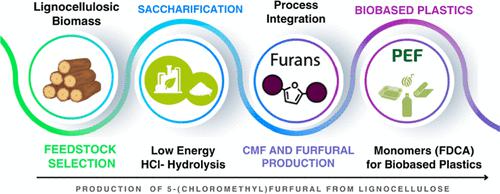当前位置:
X-MOL 学术
›
ACS Sustain. Chem. Eng.
›
论文详情
Our official English website, www.x-mol.net, welcomes your
feedback! (Note: you will need to create a separate account there.)
Production and Downstream Integration of 5-(Chloromethyl)furfural from Lignocellulose
ACS Sustainable Chemistry & Engineering ( IF 7.1 ) Pub Date : 2023-12-01 , DOI: 10.1021/acssuschemeng.3c05525 Jorge Bueno Moron 1, 2 , Gerard van Klink 1, 2 , Gert-Jan M Gruter 1, 2
ACS Sustainable Chemistry & Engineering ( IF 7.1 ) Pub Date : 2023-12-01 , DOI: 10.1021/acssuschemeng.3c05525 Jorge Bueno Moron 1, 2 , Gerard van Klink 1, 2 , Gert-Jan M Gruter 1, 2
Affiliation

|
The importance of reducing the strong dependence of the chemical industry on fossil feedstock is no longer a debate. Above-the-ground carbon is abundant, but scalable technologies to supply alternatives to fossil-fuel-derived chemicals and/or materials at the world scale are still not available. Lignocellulosic biomass is the most available carbon source, and a first requirement for its valorization is the complete saccharification of its sugar-bearing components. HCl-based technologies can achieve this at 20 °C and ambient pressure. These principles were disclosed in the 1920s, but the inability to economically separate sugars from acids impeded its commercialization. Avantium Chemicals B.V. developed a modern version of this “Bergius” highly concentrated acid hydrolysis, in which the saccharides in HCl are transformed into furanics without any prior purification, in particular, to 5-(chloromethyl)furfural (CMF). Saccharide conversion to CMF was developed by Mascal in the early 2000s. CMF is extracted in situ using immiscible organic solvents, allowing for an easy product separation. This study not only targets to investigate the viability and optimization of this integrated process but also aims to predict the outcome of the CMF formation reaction by applying design of experiment techniques from the hydrolyzed saccharides varying a broad range of reaction parameters.
中文翻译:

以木质纤维素为原料生产 5-(氯甲基)糠醛并进行下游整合
减少化学工业对化石原料的强烈依赖的重要性已不再是一个争论。地上碳储量丰富,但在世界范围内仍然没有可扩展的技术来提供化石燃料衍生化学品和/或材料的替代品。木质纤维素生物质是最可用的碳源,其增值的首要要求是其含糖成分的完全糖化。基于 HCl 的技术可以在 20 °C 和环境压力下实现这一目标。这些原理在 20 世纪 20 年代被公开,但无法经济地从酸中分离糖阻碍了其商业化。 Avantium Chemicals BV 开发了这种“Bergius”高浓度酸水解的现代版本,其中 HCl 中的糖类无需任何事先纯化即可转化为呋喃,特别是 5-(氯甲基)糠醛 (CMF)。将糖转化为 CMF 是由 Mascal 在 2000 年代初期开发的。 CMF 使用不混溶的有机溶剂进行原位萃取,可轻松实现产品分离。本研究不仅旨在研究该集成过程的可行性和优化,而且旨在通过应用不同反应参数范围内的水解糖的实验技术设计来预测 CMF 形成反应的结果。
更新日期:2023-12-01
中文翻译:

以木质纤维素为原料生产 5-(氯甲基)糠醛并进行下游整合
减少化学工业对化石原料的强烈依赖的重要性已不再是一个争论。地上碳储量丰富,但在世界范围内仍然没有可扩展的技术来提供化石燃料衍生化学品和/或材料的替代品。木质纤维素生物质是最可用的碳源,其增值的首要要求是其含糖成分的完全糖化。基于 HCl 的技术可以在 20 °C 和环境压力下实现这一目标。这些原理在 20 世纪 20 年代被公开,但无法经济地从酸中分离糖阻碍了其商业化。 Avantium Chemicals BV 开发了这种“Bergius”高浓度酸水解的现代版本,其中 HCl 中的糖类无需任何事先纯化即可转化为呋喃,特别是 5-(氯甲基)糠醛 (CMF)。将糖转化为 CMF 是由 Mascal 在 2000 年代初期开发的。 CMF 使用不混溶的有机溶剂进行原位萃取,可轻松实现产品分离。本研究不仅旨在研究该集成过程的可行性和优化,而且旨在通过应用不同反应参数范围内的水解糖的实验技术设计来预测 CMF 形成反应的结果。






























 京公网安备 11010802027423号
京公网安备 11010802027423号